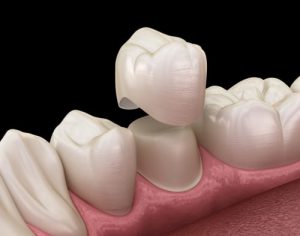The outside of each tooth is covered by an extremely hard layer called enamel. Although it is very strong, teeth can be weakened and undermined by many factors including;
- Trauma
- Chips/Breaks
- Decay
- Malformation of the enamel
CROWNS
If damage to the tooth is extensive, sometimes a crown is the best way to save the tooth and strengthen it. A crown fits over the existing natural tooth crown, similar to a thimble on a finger. It covers the entire crown down to the gum-line, it is specifically made in a laboratory to fit your tooth shape, and then cemented into place by your dentist

BRIDGES
Bridges are used to replace one or more missing teeth. They consist of an artificial tooth anchored to natural teeth on either side of the gap. This requires a crown to be placed on at least one but in most cases both of the supporting natural teeth. The crown/s and the artificial tooth are all bonded together and are cemented in place in one piece, therefore bridging and replacing the gap. If the supporting teeth are severely broken down or have large fillings, a bridge has the added benefit of strengthening them with a crown as well as bridging the gap.

Crowns and bridges are usually made of porcelain and gold alloy. They are very strong and the porcelain outer layer can be colour matched to your teeth, therefore, looking like your natural tooth.
In some cases where; the tooth is not visible in your smile and the biting or grinding forces on your tooth are extremely heavy, an all gold crown can be used. This has added strength, waring power and can be made extremely thin where minimal biting space is available. Whilst this has been common practice in the past, and is still common practice in many countries, the added aesthetic benefits of porcelain is the preferred option unless a patient requests it.
What does the procedure involve?
Crown and bridge procedures usually require two appointments. One appointment to prepare the tooth for the crown, and a second appointment approximately 2-3 weeks later to cement the permanent crown. In between these appointments you will have a temporary crown over the tooth to protect it until your permanent crown is cemented on. In cases where you are having a bridge placed, this same procedure is performed on all teeth involved.
First preparation appointment
Once your tooth is numbed using a local anaesthetic, a small impression is taken of your tooth to record its shape so that a temporary crown can be placed over the tooth at the end of the appointment.
The tooth is then shaped using a drill, making it smaller by one to two millimetres all around the tooth. After the tooth is reduced, another more accurate impression is taken of both your upper and lower teeth. These impressions are sent to a dental technician who makes the crown to the specifications indicated by your dentist (eg shape, colour etc).
The first impression taken at the beginning of the appointment is filled with a tooth coloured material and placed back into your mouth for approximately 2 mins before being taken out. This material becomes your temporary crown. Once it is shaped and smoothed, it is placed on your tooth with a temporary cement.
Second cementation appointment
After your tooth is numbed using a local anaesthetic, the temporary crown is removed from your tooth. The tooth is cleaned of any residual temporary cement. The dentist will try your permanent crown on your tooth to check that it fits correctly, is comfortable and that the colour shade matches your teeth. The crown is then cemented onto your tooth using a permanent cement.


















